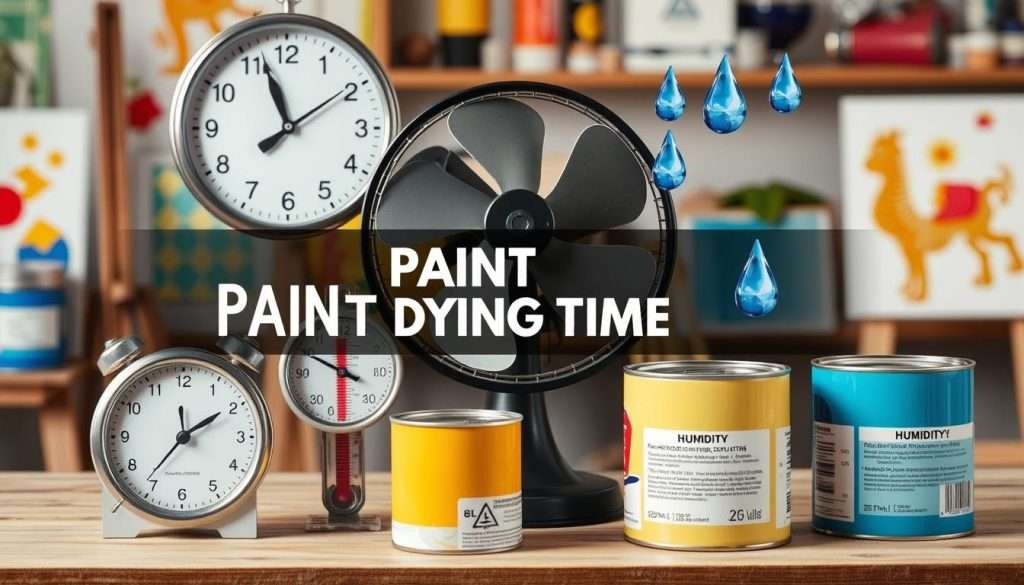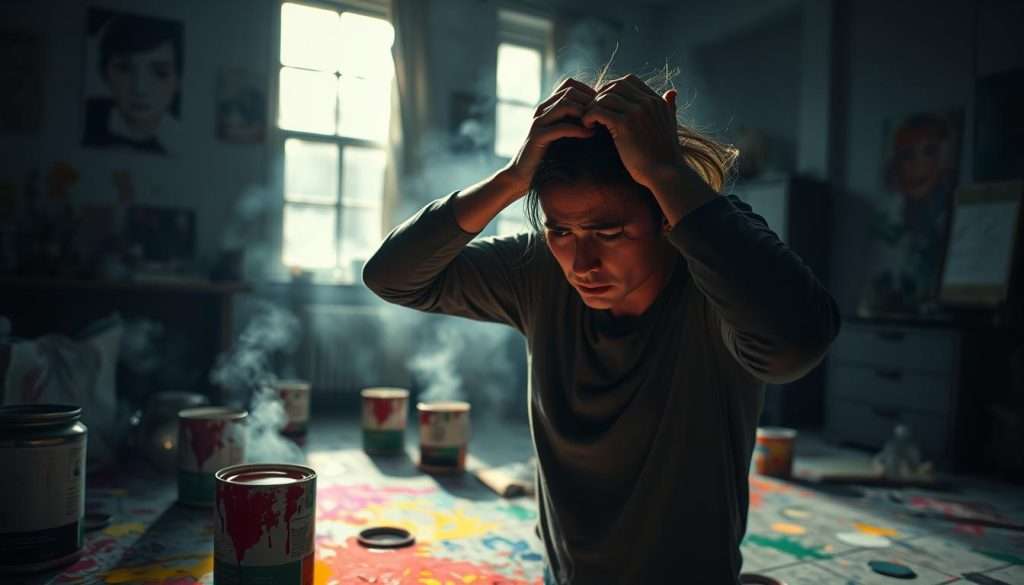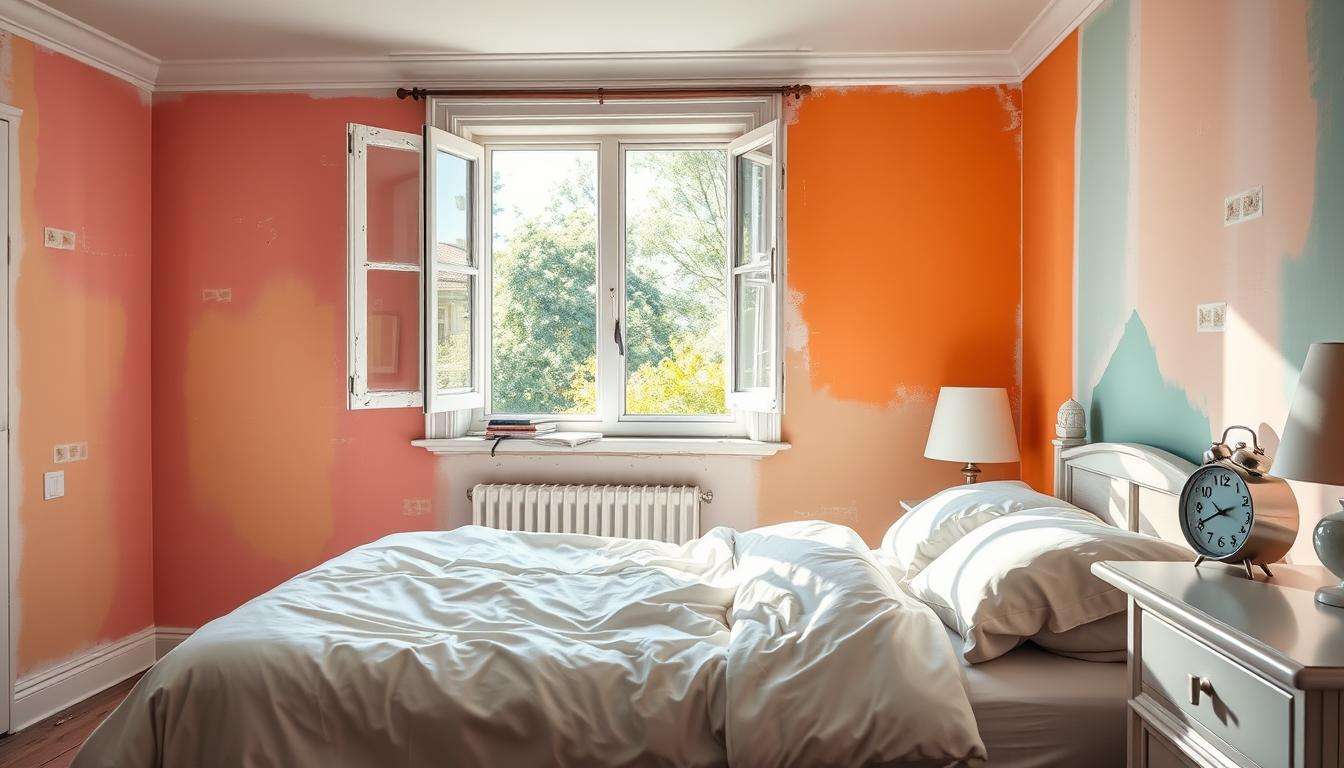Many homeowners wonder, “How long after painting can I sleep in the room?” It’s important to know how paint dries and affects air quality. This knowledge keeps you and your family safe in newly painted areas.
Water-based paints usually dry in about four hours. Oil-based paints take around 24 hours. Young kids are very sensitive to paint fumes. So, it’s best to keep babies in another room for two to three days.
Good air flow is key when paint is drying. Open windows, use fans, and make sure air moves well. This helps get rid of fumes and makes it safer to go back into the room.
Understanding Paint Chemicals and Their Effects
To keep our homes safe after painting, we need to know about paint chemicals. These chemicals affect the air we breathe and our health.
Common Chemicals Found in Paint
Most paints have volatile organic compounds (VOCs). These evaporate when the paint dries. Some common ones are:
- Formaldehyde
- Benzene
- Toluene
These chemicals can make the air inside our homes worse.
How These Chemicals Affect Air Quality
When paint dries, VOCs get released into the air. This makes the air inside our homes less clean. It can cause breathing problems and make health issues worse.
Short-Term and Long-Term Health Risks
Being around paint fumes can harm our health. Short-term problems include:
- Headaches
- Dizziness
- Eye irritation
Long-term exposure can lead to serious health issues. This includes liver damage and problems with the nervous system. Knowing this helps us paint safely by using good ventilation and safety steps.
Factors Influencing Drying Time
Knowing what affects paint drying time is key to a safe space after painting. Many things can change how fast paint dries. This includes when it’s safe to go back into the room.
Type of Paint Used: Water-Based vs. Oil-Based
The paint you pick is very important for drying time. Water-based paints, like latex, dry quicker than oil-based paints. Here are some general times to keep in mind:
- Water-based paint: Touch dry in 1-2 hours, fully dry in 4-6 hours, and wait 24 hours before sleeping.
- Oil-based paint: Touch dry in 6-8 hours, but wait 48-72 hours before sleeping.
Room Temperature and Humidity Levels
Room temperature and humidity greatly affect drying time. The best conditions are:
- A temperature of 60-80°F (15-27°C).
- Low humidity, as high humidity slows drying and can cause mold.
Low humidity not only speeds up drying but also prevents mold.
Ventilation and Airflow Considerations
Good ventilation helps paint dry faster and gets rid of smells. The best ways are:
- Open windows for fresh air.
- Use fans to move air and lower humidity.
Good air flow gets rid of paint smells, making the room safer for sleep. Remember these tips for a better experience after painting.

| Type of Paint | Touch Dry | Fully Dry | Recommended Waiting Period Before Sleeping |
|---|---|---|---|
| Water-Based Paint | 1-2 hours | 4-6 hours | 24 hours |
| Oil-Based Paint | 6-8 hours | 48 hours+ | 48-72 hours |
General Guidelines for Sleeping in a Recently Painted Room
It’s important to know when it’s safe to sleep in a room painted recently. The timing depends on the paint type and the environment. Here are some tips to help you safely return to your newly painted room.
Recommended Waiting Times for Different Paint Types
Different paints dry and cure at different rates. This affects when you can safely go back to normal activities:
- Low-VOC and Zero-VOC Paints: You can usually sleep in a room painted with these the same day.
- Latex Paint: Wait 4-6 hours before sleeping. Some people prefer to wait a full day because of the smell.
- Oil-Based Paint: Wait at least 24 hours. It can take up to two weeks to fully cure.
Signs That It’s Safe to Return
Before going back, look for these signs of a safe room:
- No strong paint smell means lower VOC levels.
- Make sure windows are open for good air flow.
- The air should feel fresh and easy to breathe.
Why Ventilation is Key
Good air flow is very important for indoor air quality. It helps get rid of paint vapors, even when the paint looks dry. This reduces health risks from VOCs. Here’s how to improve air flow:
- Open windows wide for better air flow.
- Use fans to keep the air moving.
- Try cross-ventilation by creating opposing air flows.
| Paint Type | Waiting Time Before Safe Sleep | Curing Time |
|---|---|---|
| Low-VOC Paint | Same day | Up to 2 weeks |
| Zero-VOC Paint | Immediate | Up to 2 weeks |
| Latex Paint | 4-6 hours | 2-3 days |
| Oil-Based Paint | At least 24 hours | Up to 2 weeks |
By following these guidelines, you can safely move back into your newly painted rooms. Watch the paint type and keep the air flowing well.
Impact of Children and Pets
Painting needs to be safe for kids and pets. They are more sensitive to paint smells. So, we must take extra care.
Special Considerations for Children
Little kids are very sensitive to paint smells. It’s best to keep them away from new paint for a few days. This helps keep them safe.
Many paints today are safer. They have less bad stuff in them. But, it’s still good to wait a bit longer for children safety. Playing outside is a fun way to keep them safe and happy.
Keeping Pets Safe During Painting
Keeping pets safe is just as important. Paint smells can make them sick. This can lead to breathing problems and even cancer.
So, keep pets in a safe place while painting. Make sure it’s well-ventilated. This keeps them away from bad smells. It makes everyone feel better.
Addressing Concerns About Fumes
Watch for signs of trouble in kids and pets. If they cough, seem tired, or act strange, it might be the paint. This means they’re not feeling well from the chemicals.
If this happens, wait until the air is clean again. Good air and safe paints help a lot. For more tips, check out information on kids’ safety in new.
Preventive Measures and Safety Tips
Keeping safe during painting is very important. Using smart methods helps protect you and your family from bad fumes. It also makes the air cleaner.
Using Low-VOC or Zero-VOC Paints
Choosing paints with low or no VOCs is a good idea. These paints are better for your health and the planet. They make your home a safer place for your family.
Proper Ventilation Techniques
Good air flow is key to getting rid of paint smells. Here are some ways to do it:
- Open windows and doors to let air in.
- Use exhaust fans to help get rid of smells faster.
- Box fans can also help move air around.
Start these steps right after painting. Keep them up for at least 24 hours. If smells are still there, keep going longer.
Utilizing Air Purifiers
Using air purifiers with HEPA filters in painted rooms helps a lot. They catch bad stuff in the air, like paint smells. This makes your home safer and air fresher faster.
What to Do If You Feel Unwell After Painting
Feeling sick after painting is a worry. It’s key to know the signs of paint fumes and act fast. This way, you can stay safe if you feel bad.
Recognizing Symptoms of Paint Fumes
Common signs of paint fumes include:
- Headaches
- Dizziness
- Respiratory issues
- Irritation of the eyes, nose, or throat
Spotting these signs early helps you protect yourself right away.
Immediate Steps to Take
If you feel sick after painting, do these things:
- Leave the painted area.
- Go to a place with fresh air.
- If needed, use a fan to help air move.
These steps can lessen your exposure to bad fumes.
When to Seek Medical Attention
If your symptoms don’t go away or get worse, get medical help. Long-term exposure can be very dangerous. Always put your health first.

Conclusion: Best Practices for Painting and Air Quality
Painting your home can affect the air quality. It’s important to know the risks and follow guidelines. This article talked about paint chemicals, drying times, and safety for kids and pets.
Using this knowledge helps make your home safe and look great.
Summary of Key Points
It’s important to wait before going back into a painted room. Low-VOC or zero-VOC paints need 24 to 48 hours. Oil-based paints might take up to two weeks.
Good ventilation is key. Open windows and use fans to lower VOCs. This keeps your air quality good.
Final Recommendations for Safety
Choose low-VOC or zero-VOC paints for your family’s health. They reduce risks from paint fumes, especially for kids and pregnant women. Watch for any discomfort signs and ask experts if you’re unsure.
Following these tips lets you enjoy your painted home safely.
